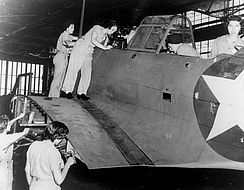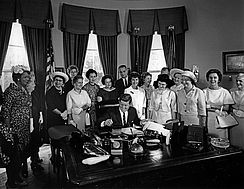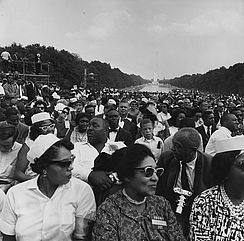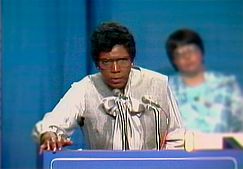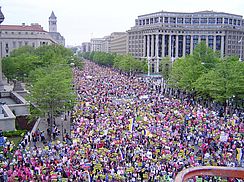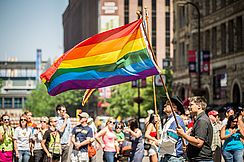Politics & Social Movements
Separate Roads to Feminism
How did resilience, persistence and forgiveness guide Martha Cotera on the road to Chicana feminism?
Excerpt from “A Crushing Love: Chicanas, Motherhood and Activism,” a film by Sylvia Morales. (Running time 6:45) Used with permission. The complete film is available from Women Make Movies.
Many critics of second-wave feminism have bemoaned the “whiteness” of the movement and the lack of participation by black women and other feminists of color. But instead of framing the question as “Why didn’t African-American women and Chicanas join white groups?” perhaps it is more fruitful to look at what these women were actually doing — and when. Black and Chicana feminist organizing was not merely a reaction to feeling unwelcome or marginalized by the white feminist movement. Such a scenario downplays the agency of women of color in identifying their own oppression and taking steps to address it. More importantly, the timetable is wrong. Black and Chicana feminism cannot be explained as variations or offshoots of the white movement, because all three strands were developing simultaneously. In addition, black and Chicana feminists were fundamentally shaped by their distinctive experiences in the broader civil rights and Chicano movements, respectively.

Demita Frazier remembers how African-American feminists worked to establish a new and independent voice in the women’s movement.
Excerpt from “A Moment in Her Story: Stories from the Boston Women's Movement,” a film by Catherine Russo. (Running time 5:08) Used with permission. The complete film is available from Catherine Russo Documentaries.
Changes in the civil rights movement starting in the mid-1960s, including the militant embrace of black power and black nationalism, set in motion the emergence of black feminism. As early as 1966, black women came together as feminists to critique the increasingly masculinist tone of the movement. And they did this in their own groups, such as the Third World Women’s Alliance (founded 1970) and the National Black Feminist Organization (1973), rather than as part of white feminist organizations, which they deemed insufficiently attentive to race and class oppression and too interested in cultural, rather than economic, change. Early anthologies such as Toni Cade Bambara’s The Black Woman (1970), which reprinted Frances Beal’s influential article “Double Jeopardy: To Be Black and Female,” introduced the existence of the black feminist movement to a wider audience.
An especially influential document of black feminist theory was written in 1977 by the Combahee River Collective, a group of black feminists in the Boston/Cambridge area who took their name from Harriet Tubman’s 1863 guerrilla action in the Port Royal region of South Carolina that freed more than 750 slaves. Their manifesto functions not only as an ideological treatise but also as an attempt to describe “what oppression is comprised of on a day-to-day basis.” The Combahee River Collective refused to separate the multiple oppressions that shape black women’s lives: “We struggle together with Black men against racism, while we also struggle with Black men about sexism.” It also spoke out against homophobia, staking a claim for black lesbians in the broader freedom struggle.
Chicana feminists did not prioritize cross-racial organizing, such as seeking out coalitions with black feminists; they chose instead to work for a greater political presence for women in the Chicano movement. In their organizing and outreach they proudly pointed to the large roles that women such as Luisa Moreno and Josefina Fierro had traditionally played in Mexican and Mexican-American struggles for social change. Important organizational milestones included the 1969 formation of Las Hijas de Cuauhtémoc at California State University at Long Beach, the 1970 founding of the Comisión Femenil Mexicana Nacional, and the first National Chicana Conference, held in Houston in 1971.
Benita Roth calls the tendency for activists, including feminists, to build their movement organizations with members of their own racial or ethnic group “organizing around one’s own oppression,” also referred to as “identity politics.” The core concept behind identity politics is the existence and creation of a self-identified social interest group, usually defined in opposition to the dominant society. A feeling of shared oppression, injustice, or exclusion, often articulated through the process of consciousness-raising, leads to political action for greater self-determination. Such an approach was obviously central to the emergence of second-wave feminism. If women didn’t identify themselves as part of a group, where was the “we” in feminism?

The development of feminist consciousness among Asian American women shared many similarities with black and Chicana feminism, although it emerged somewhat later. Many Asian American women were at first more likely to ally with Asian American men, prioritizing questions of race and class over gender. By the 1970s, however, Asian American women began to address women’s issues on the grassroots level through groups such as the Asian Pacific Health Project in Los Angeles and the Asian Pacific Outreach Center in Long Beach. National networks, such as the National Organization of Pan Asian Women and Asian American Women United (both founded in 1976), soon followed.
Identity politics was also extremely important to the emergence of gay liberation, commonly dated to the Stonewall Riot in New York City in 1969, when male patrons at a gay bar fought back against arbitrary police harassment. The movement gained momentum, bringing new pride and a sense of unity to men and women who had been forced to live “in the closet” by a society that identified their behavior as deviant. For gay men and lesbians to band together to demand better treatment and recognition as a group, they first had to declare their shared identity and “come out” to the heterosexual community.
The emerging lesbian consciousness was closely related to the rise of the feminist movement, which gave both gay and straight women a political context for addressing their oppression. Here the trajectory was not a separate road to feminism but a struggle to include issues of lesbianism and sexuality wherever feminism was taking root. From the start, this partnership was troubled, with lesbianism seen by many straight feminists as a potential embarrassment just as feminism was beginning to reach a mass audience. Other straight feminists were unwilling to confront what Charlotte Bunch called their “heterosexual privilege” to express solidarity with the concerns of lesbians. Betty Friedan and the New York chapter of NOW led a purge of the “lavender menace” in 1970, declaring lesbian feminists unwelcome in the movement they helped build. Though Friedan later revised her position, the gay/straight split fractured the movement. Eventually, however, straight feminists began to acknowledge that lesbians faced many of the same problems in employment, housing, and obtaining credit as other women; obtaining parenting rights was even more challenging for them. At the same time, lesbians also struggled for parity within the larger gay rights movement, where gay men tended to dominate the agenda.

At the beginning of the twenty-first century, the key term in feminist theory is not “identity politics” but “intersectionality,” a word defined by black theorists in the 1980s. Simply put, intersectionality recognizes that there is not one single oppression operating independently, but that identities of race, class, gender, and sexual orientation are all interrelated and must always be acknowledged when plotting political strategies and analyzing contemporary conditions.
Intersectionality is central to Native feminism. (The term “Native” refers to all indigenous women in the Americas.) While white feminism is often portrayed negatively as part of the imperial project of U.S. domination of its indigenous peoples, Native feminism posits that racial and gender justice are linked and that women’s issues such as domestic and sexual violence can and should be addressed as part of the larger struggle for sovereignty. Because of the diversity of Native communities, Native feminism in itself is complex and varied; trying to sort indigenous women into “feminist” and “non-feminist” categories belies their multiple perspectives. At the core of Native feminism is an awareness of interlocking oppressions and a determination to overcome them simultaneously, rather than singling out women’s oppression alone.
One of the first articulations of the concept of intersectionality was the Combahee River Collective Statement in 1977. These multiple, overlapping identities are in fact a good metaphor for the diversity of modern feminism, which, if it is doing its job, should recognize the differences among women at the same time it generalizes about the conditions common to all women.
How to Navigate our Interactive Timeline
You will find unique content in each chapter’s timeline.
Place the cursor over the timeline to scroll up and down within the timeline itself. If you place the cursor anywhere else on the page, you can scroll up and down in the whole page – but the timeline won’t scroll.
To see what’s in the timeline beyond the top or bottom of the window, use the white “dragger” located on the right edge of the timeline. (It looks like a small white disk with an up-arrow and a down-arrow attached to it.) If you click on the dragger, you can move the whole timeline up or down, so you can see more of it. If the dragger won’t move any further, then you’ve reached one end of the timeline.
Click on one of the timeline entries and it will display a short description of the subject. It may also include an image, a video, or a link to more information within our website or on another website.
Our timelines are also available in our Resource Library in non-interactive format.
Timeline Legend
Yellow bars mark entries that appear in every chapter
This icon indicates a book
This icon indicates a film
1971 The Click! Moment
The idea of the “Click! moment” was coined by Jane O’Reilly. “The women in the group looked at her, looked at each other, and ... click! A moment of truth. The shock of recognition. Instant sisterhood... Those clicks are coming faster and faster. They were nearly audible last summer, which was a very angry summer for American women. Not redneck-angry from screaming because we are so frustrated and unfulfilled-angry, but clicking-things-into-place-angry, because we have suddenly and shockingly perceived the basic disorder in what has been believed to be the natural order of things.” Article, “The Housewife's Moment of Truth,” published in the first issue of Ms. Magazine and in New York Magazine. Republished in The Girl I Left Behind, by Jane O'Reilly (Macmillan, 1980). Jane O'Reilly papers, Schlesinger Library.



















